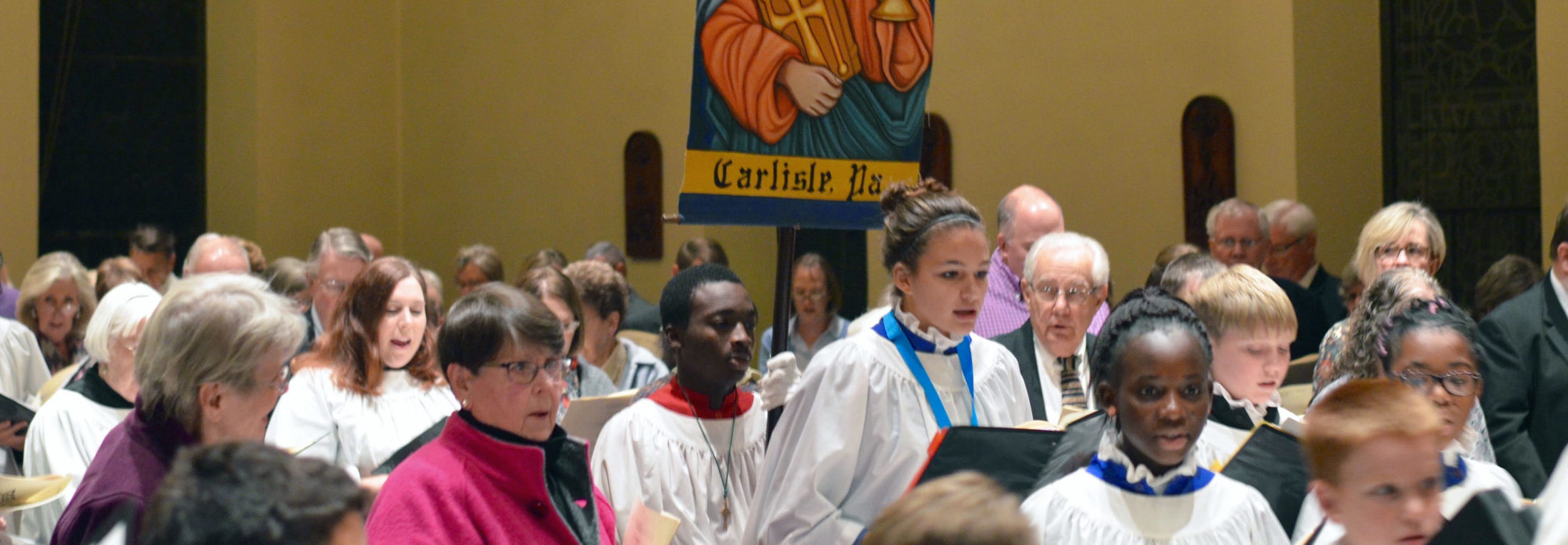Sermon preached by the Rev. Melissa Q. Wilcox
Sixth Sunday after Pentecost:
The word sandwich can seem pretty straightforward. Most of us imagine bread, a slice of ham or turkey, maybe some lettuce and tomato and, perhaps, mayo or mustard. When I moved to Philadelphia, however, I needed to learn a whole new lingo for large sandwiches. Having grown up in New England, I knew that large sandwiches were called grinders. Later, having moved to Wisconsin, they were named subs. But, once we moved to Philadelphialand, and settled in close proximity to the Wawa Estate, I discovered there were no such things as sandwiches–or grinders or subs, but only hoagies. Wawa brought me a whole new way to understand and define something as simple as a sandwich.
Well, today I am going to offer you another definition of sandwich. Believe it or not, this gospel passage that we hear today is called a Markan sandwich. No, it’s not a piece of pita with hummus and olives. Rather, it is a story which starts with one narrative, which is then interrupted by another story, and then ultimately returns to the first narrative. We call this a Markan sandwich because the gospel writer intentionally pairs these stories together so that they can be heard in tandem. Mark’s placement of these two stories inside each other are signals that he wants us to hone in on their similarities.
So, we have two portraits. One is of a religious leader who seeks out Jesus because his 12 year old daughter is sick. Both the fact that she is a girl and 12 years old should speak to us. 12 is an important number in the Bible, the 12 disciples, right? 12 is also an important time for young girls at it is often the onset of puberty. Even the mention of a young girl as a character in the story is significant, as children were often not mentioned, especially girls. So, here we have in scene 1, a religious leader, who is aware that Jesus can perform miracles, and he seeks Jesus out. We shouldn’t forget that leading up to this passage, Jesus heals a demoniac, a Gentile in fact, but now Jesus is being sought out from a leader of the people of the covenant.
The scene is interrupted by another woman. Again, significant because she is sick as well. And how long has she been ill? 12 years. Yes, 12 again. 12 tribes of Israel anyone? We know that she has been hemorrhaging. There is lots of speculation about the kind of hemorrhaging, but it’s been 12 years and the important takeaway is that she has been made ritually unclean because of her bleeding. We do know, however, that she comes from within the Jewish customs because the Levitical codes are cited when referencing her uncleanliness. The shortened version of the interruption is that she captures our imagination by crawling through a crowd and touching Jesus’ hem. His power comes out of him, which he feels, and she is healed. You think the meat of the story might stop here, but Mark explicitly states, “Then the woman knowing what had happened to her, came and fell at his feet and, trembling with fear, told him the whole truth.” And his response was, “Daughter your faith has healed you. Go in peace and be freed from your suffering.”
As this dramatic scene closes, sadly we return to the first portrait. While Jesus was busy attending to the hemorrhaging older woman, we hear that Jairus daughter has died. Jesus’ response is strange. He says, “Don’t be afraid.Just believe.” Not exactly Hallmark card worthy words of comfort. As Jesus prepares to bring his inner circle with him, Peter, James, and John, who we know will be important at the later at the Transfiguration, they arrive at the home. Jesus lays hands on the girl in the presence of her parents, and calls her to stand up. And, all in a day’s work, Jesus has healed two people, one who was ritually unclean and one who was comatose. Jesus levels the playing field reminding us that God shows no partiality between Jew and Gentile. And, even more importantly, Jesus loves women–even women that bleed, ritually unclean women.
But, what about the role of fear and faith in this passage? With the hemorrhaging woman, we see an example of a person who defied cultural norms –a rare act of boldness born out of her faith. She was literally determined to touch this man based on what she had heard about him. Fear was not going to impede her faith. And, faith was not belief, but rather fortitude and action. She crawled through a crowd to touch him and then fell at his feet as she accepted culpability for touching him. Even though she was afraid, she told him the whole truth.
In contrast, Jesus throws the words, “Do not fear, only have faith.” at Jairus and his community after the young girl dies. Now, any of us who have loved a twelve year old, would be filled with all kinds of fear after the death of a child that age. How do I tell her brothers and sisters? What do I do with her clothes? How do I not fall into a crumpled ball as I walk by her bedroom? But fear is framed as an impediment to faith in this statement.
In Mark’s gospel, fear does not go away as a theme. The disciples are afraid when Jesus walks on water. At the Transfiguration, there is fear and trembling. And, of course as the Kingdom of God, breaks into this world, fear is manifest in the chief priests and the leaders and the Pharisees. Fear permeates this gospel as Jesus goes about becoming the One who came to seek out and save the lost.
And, the most famous scene at the Resurrection as quoted in the Gospel of Mark is this:
So they went out and fled from the tomb, for terror and amazement had seized them; and they said nothing to anyone, for they were afraid.[a]
I wonder, however, if Mark deeply understood human nature. I wonder if fear is such a significant part of this gospel because fear is not only a part of the human condition, but it is often the precursor to very important parts of life. Fear and trembling are words used when one is about to take an oath. Talk to any pregnant woman who has never been through labor before and if she doesn’t mention that she is afraid she is probably not telling the truth. Ask any adult about to move cross country for a new job and he most likely will tell you he is a bit afraid. Fear is not weakness. Fear is recognition of a feeling that then needs sorting with God’s help. The bleeding woman stayed in the presence of Jesus even though she was completely afraid of what he might say or do. Jairus, the leader of the synagogue, was in a deep state of fear after his daughter had ceased to breathe. Yet he pursued Jesus against the advice of his elders. Both vignettes show us people who were deeply afraid, and yet despite their fear, still sought out Jesus.
On this hot summer day, I can promise you one thing. Jesus was not afraid to break down societal walls and confront the fears of communities of which he was a part. He was not timid in showing the world that little girls and women were worthy of his healing presence. But, I can’t promise you that in your life with God you will not be afraid. Even the women at the tomb fled that moment with fear and trembling in their hearts, but somehow the story still got told. And because they moved through that fear and terror, you and I are here today, sweating in this sacred place, hearing about the marvelous works of God in this Markan sandwich. With his words reframed for us, “Don’t be afraid. Just believe…”

